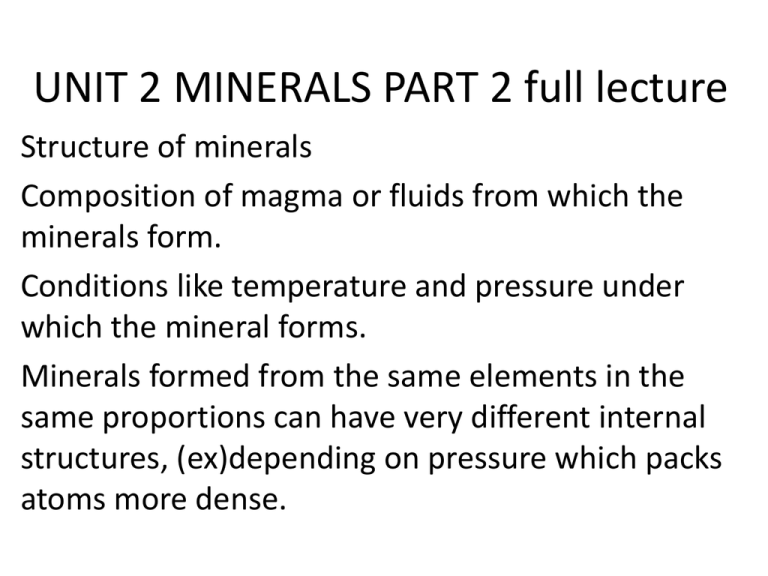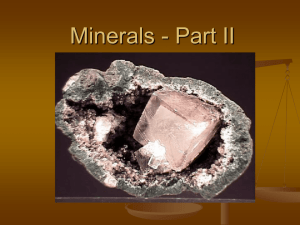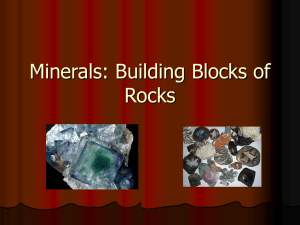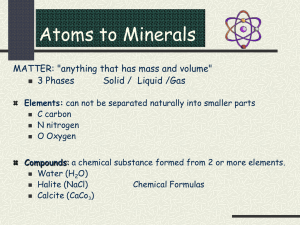File
advertisement

UNIT 2 MINERALS PART 2 full lecture Structure of minerals Composition of magma or fluids from which the minerals form. Conditions like temperature and pressure under which the mineral forms. Minerals formed from the same elements in the same proportions can have very different internal structures, (ex)depending on pressure which packs atoms more dense. • 1. Polymorphs- different minerals with the same chemical composition but differing structures. • Graphite is a form of pure carbon. • Its crystal structure forms sheets • of carbon Diamond is another form of pure carbon. It forms deep in the Earth at high pressures and it’s the hardest substance. It crystal structure is dense and compact. • 2. Mineral Identification • Minerals are identified by their physical and optical properties. Some properties are more diagnostic then others so a combination is used to determine the mineral. • Properties: color, luster, hardness, streak, Crystal form, cleavage, fracture, reaction to acid, taste, smell, magnetization, optical properties, elasticity, and specific gravity. • a. Color can be misleading, some impurities in the mineral can change its color. • b. Luster appearance of light reflected from minerals. Eamples include metallic luster, nonmetallic luster, glassy luster, and resinous luster. c. Hardness measures minerals resistance to scratching. Mah’s hardness scale. d. Crystal form reflects internal arrangement of atoms The shape of a well-formed crystals reflects light by arrangement of atoms. Anhedral crystals form when crystals don’t have room to grow and bump into each other feldspar in an igneous rock Irregular boundaries between crystals due to interference during growth Anhedral crystals formed by crowding during growth Quartz geode Crystal terminations of euhedral quartz Anhedral quartz crystals formed by crowding during growth Euhedral crystals of amphibole in a volcanic rock Asbestos Asbestos -group of silicate minerals that readily separate into fibers that are: thin, flexible, heat resistant, chemically inert many uses Cleavage: Tendency to break along preferred planes of weakness. Cleavages represent directions of weaker bonding between atoms. Conchoidal fracture in volcanic glass Streak: Color of mineral in its powdered form Hematite: Iron oxide Carbonate minerals, like calcite, dissolve in acid and release carbon dioxide “The Acid Test” CO2 bubbles Important Non-silicate Minerals Halides Halite (Na, Cl: NaCl) -> common table salt Sulfates Gypsum (Ca,S,O,H: CaSO4-H2O) -> calcium sulfate + water, main ingredient of plaster & other building materials Oxides Hematite (Fe, O: Fe2O3) -> steel Important Non-silicate Minerals Carbonates Calcite (Ca, C, O: CaCO3) Dolomite (Ca, Mg,C, O: CaMg(CO3)2 Found together in sedimentary rock limestone. Main ingredient to cement, roads & building stones. The Common Rock-forming Minerals Over 4000 minerals: only few dozen are abundant, making up most rocks of Earth’s crust => rock-forming minerals Only 8 elements make up most of crust’s minerals & represent over 98% of the continental crust The two most abundant elements: Silicon (Si) Oxygen (O) Question: What minerals would you expect to be most abundant on Earth? Percent of elements by WEIGHT Average composition of the Earth’s crust. The Common Rock-forming Minerals Earth’s Crust Primarily Si & O followed in abundance by Fe, Mg, Ca, Na, K, etc. Dark colored (mantle and oceanic crust) Olivine (Si, O, Fe, Mg) Pyroxene (Si, O, Fe, Mg, Ca) Amphibole (Si, O, Fe, Mg) Light colored (crust, esp. continental crust) Quartz (SiO2) - Hard, transparent Feldspar (Si, O, Al, K, Na, Ca) - Hard, white, gray, pink Clay (Mostly come from weathering feldspar) Calcite (CaCO3, shells) Limestone - Used for cement








